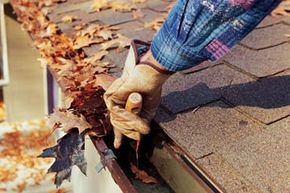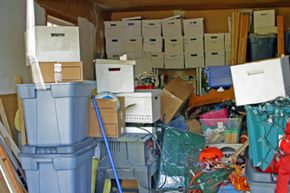Roof gutters are traces and chutes that route water off your roof. When you buy a home, the prospect of having to periodically climb up a ladder to maintain the gutters of your castle may not be at the forefront of your mind, but even though gutter maintenance may not be on your list of homeowner-friendly chores, it's a necessary part of home ownership. In fact, gutter cleaning is really important for the health of your home. Clogged gutters can cause water to pool on your roof, resulting in leaks and making a more attractive environment for some types of termites. Poor gutter maintenance can also lead to problems with siding, windows, doors and foundations from the prolonged effects of water draining on or near your walls.
Some new types of gutters have capped leaf-catching systems to keep leaves out, but even these gutter innovations aren't foolproof and need to be checked and periodically maintained. The best approach is to plan a day when you can get up close and personal with your gutters, read up on ladder safety, and dig out your heavy-duty work gloves.
Here's what you'll need:
- Narrow trowel
- Plastic garbage bag
- Stiff brush
- Safety goggles
- Hose with pressure attachment
- Heavy-duty work gloves
The easiest way to manually clean your gutters is the day after a light rain. The slightly damp leaves and dirt will come up more easily. If you're lucky enough to have a low sloping roof, you may be able to use a leaf blower to do the lion's share of the work, but if that's your plan, wait for everything in the gutters to dry out completely first.
The heaviest concentration of leaves and gunk will accumulate at the drain outlets, so start cleaning there. Use a narrow trowel to scoop up muck and dispose of it in the garbage bag; a bulb trowel is a perfect choice. You can also do it the old-fashioned way with your gloved hands, but be careful of exposed screws and sharp metal gutter edges. You can tie the bag to your belt or attach it to the ladder. If you can't get all the silt accumulation out, use the brush to work it free. Now you're ready to reposition the ladder and work on the next section of gutter.
Once you have a length of gutter completed, use the hose to remove loose silt and anything else you missed. This will also give you a chance to check how quickly your downspout drains and whether or not the slope of your gutters needs adjustment. If there's an obstruction in your downspout, you can use a plumber's snake to work it out from the bottom up.
Now you can move on to the next length of gutter.
This process will be much easier if you have a helper who can spot you on the ladder and help feed you the hose when you need it.
Gutter cleaning can be dirty work, so make sure that you, and anyone working with you on the ground, is wearing eye protection and old clothing.
While you're thinking about good gutter maintenance, take a look at how water is draining from your roofline. If you see large drips along the joints where sections of segmented gutter are attached to one another, or there are rivulets running down the walls, your gutters may need repair. If water pools under the downspout, consider investing in a sloped splash box that will reroute water away from your home's foundation.
In the next section, we'll take a look at the heart of your home, the kitchen.





